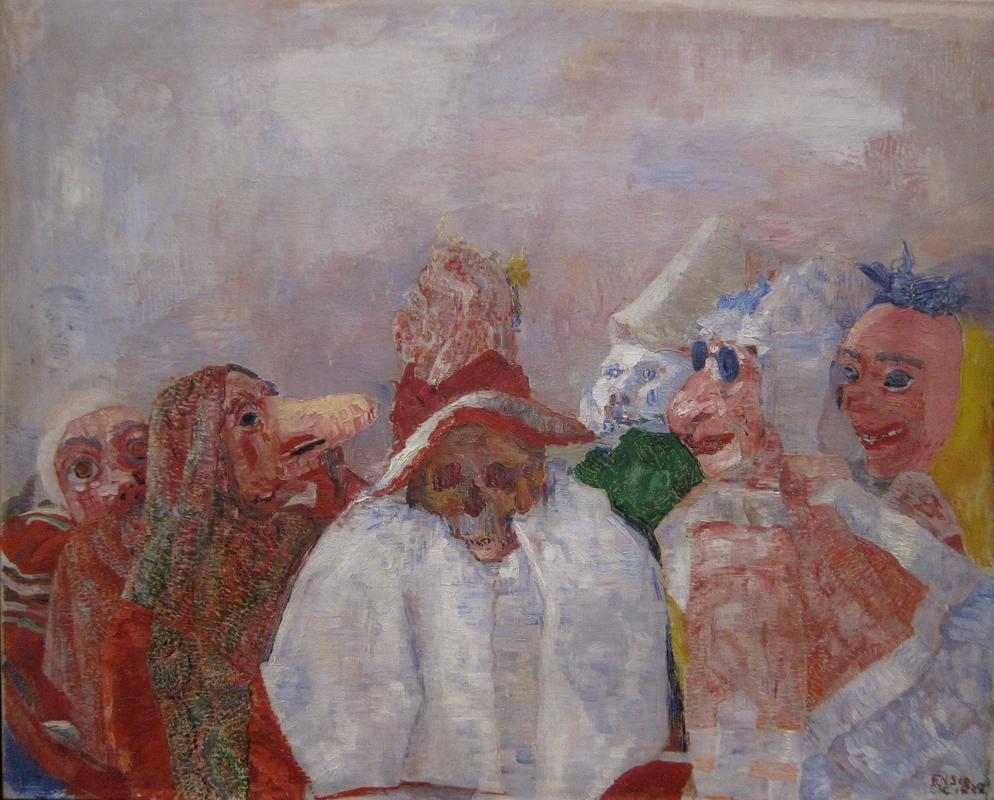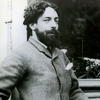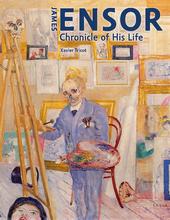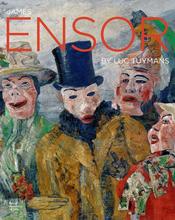More about Masks Confronting Death
- All
- Info
- Shop

Contributor
James Ensor embarks on a life-long public love affair with dead people and groups of clowns in Masks Confronting Death.
When all you have is a hammer, the saying goes, every problem starts to look like a nail. Similarly, when you spend most of your life in a mask shop, every flat surface starts to look like it needs to have a weird face attached to it. Take for example the later work of James Ensor, who was to pictures of gross people wearing creepy masks what Georgia O’Keeffe was to yonic symbols. Not only was Ensor raised by his parents in their seaside mask-and-souvenir shop, periodically taking part in the local costumed carnivals, but as an adult he did most of his work from a studio above that same store, and the effect of seeing bizarre Belgian party favors day in and day out for the duration of his formative years seems to have been rather far-reaching. After a youth spent painting rather traditional still-lifes and light-infused religious scenes that earned him little public admiration, Ensor went through a violent breakup with then popular sensibilities and decided if nobody liked him anyway he was going to spend his time painting what he wanted for a change.
Ensor was still exploring and fleshing out his mask fascination (Mascination? No? Okay, fine) while painting Masks Confronting Death (1888), but it includes a lot of the imagery that would eventually make him famous. Naturally it’s full of masked figures, but skeletons, clown-faces, and fancy dress are all on equally-prominent display. These were subjects which would occupy more and more of Ensor’s attention as the years went on. While this type of surreal, morbid iconography had showed up from time to time during his earlier years (first in 1883’s The Scandalized Masks), by the late 1880s they had become his obsession. The rest of his life was a constant cavalcade of corpses, clowns and costuming: you’ve got Skeletons Fighting Over a Hanged Man (1891), Skeletons in the Studio (1900), Pierrot and Skeletons (1907)...basically, if Ensor painted it later than 1887, then it looks like somebody’s nightmare after falling asleep to a Tom Waits album.
One fun fact that doesn’t seem to get discussed a whole lot is that Ensor appears to have been a fan of Edgar Allan Poe (which, hey, wow, go figure), having produced prints illustrating stories like “Hop-Frog” and “King Pest.” A literate observer might note similarities between the imagery in Masks Confronting Death with that in Poe’s “Masque of the Red Death,” about a crimson-clad, shroud-draped Grim Reaper infiltrating a fancy masquerade party. This hypothetical individual might go on to note that in 1886 the painter Odilon Redon had exhibited his own illustration of that story with Les XX, the art collective with whom Ensor had a pretty spectacular split at around the same time. One might further point out that Ensor had a habit of using his art to publicly tell people how little he thought of them (Christ’s Entry Into Brussels (1888), for instance, might just as easily have been titled Oh So You Philistines Like Seurat So Frigging Much Do You). If he felt a lesser painter was getting love when he could do better, he wasn’t what you’d call quiet about it. But, then again, there’s absolutely no documentation whatsoever to back such a theory about this painting up, so...you know. Do whatever you want with that.
Sources
- Johnson, Cynthia. “Ensor’s ‘Masks Confronting Death’,” MoMA, No. 5 (Autumn, 1975), p. 3.
- Schjeldahl, Peter. “The Id Factor: James Ensor’s Irreality.” The New Yorker, July 6 & 13, 2009.
- Gheeraert, Inne. “Masks.” JamesEnsor.com. Accessed 5 May 2017. http://jamesensor.vlaamsekunstcollectie.be/en/collection/themes/masks
- Canning, Susan Marie et al., James Ensor: The Temptation of St. Anthony. (Chicago: Art Institute of Chicago, 2014), 125.













